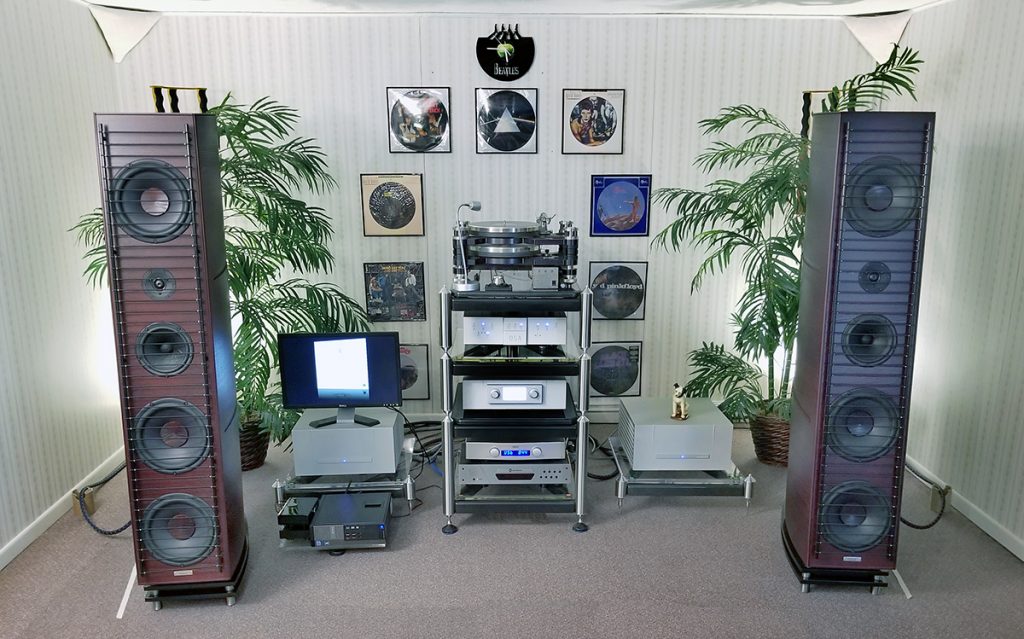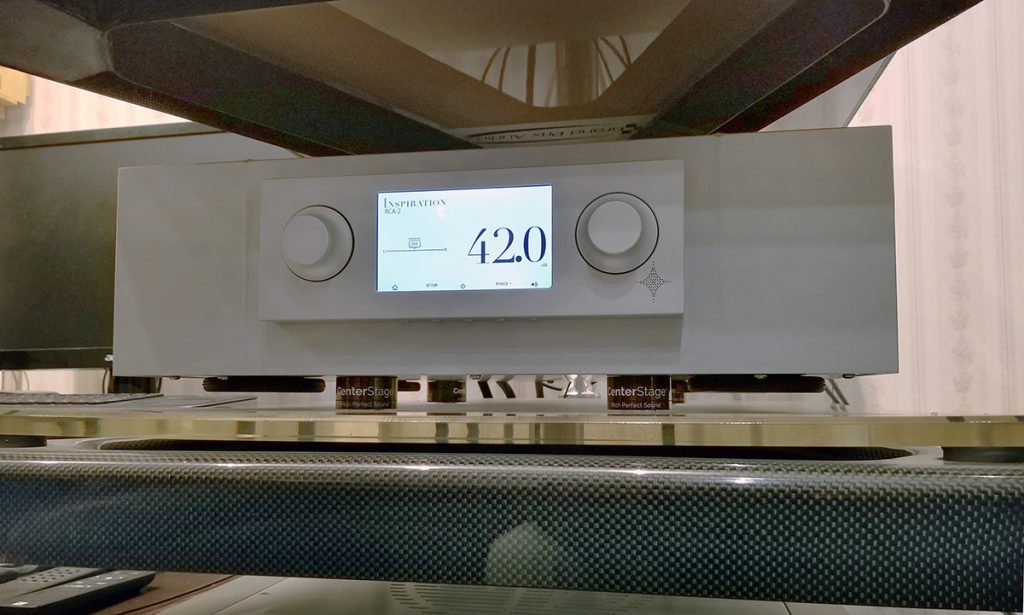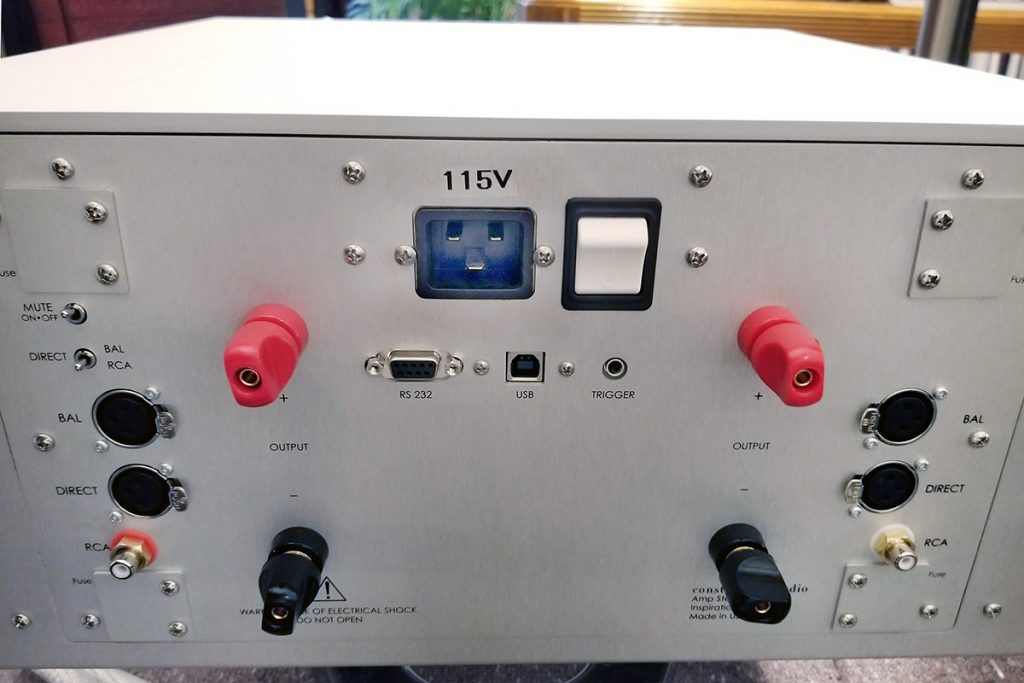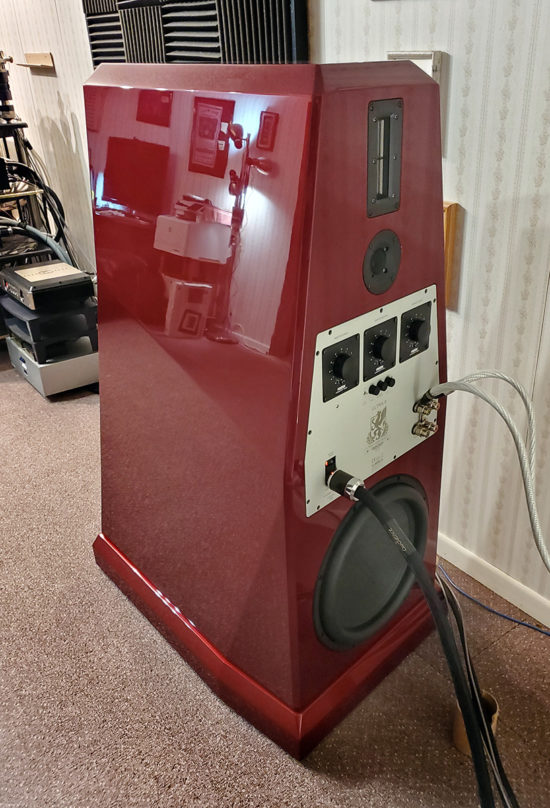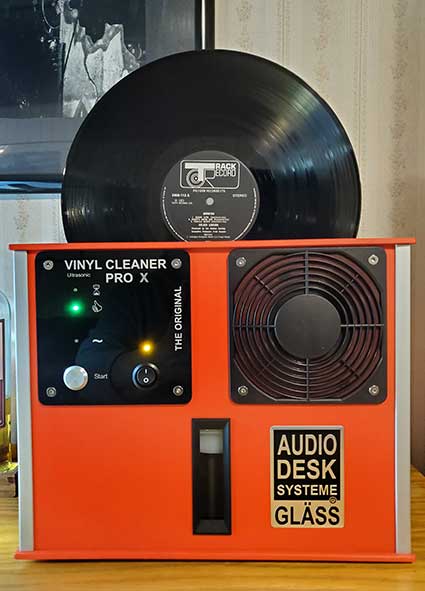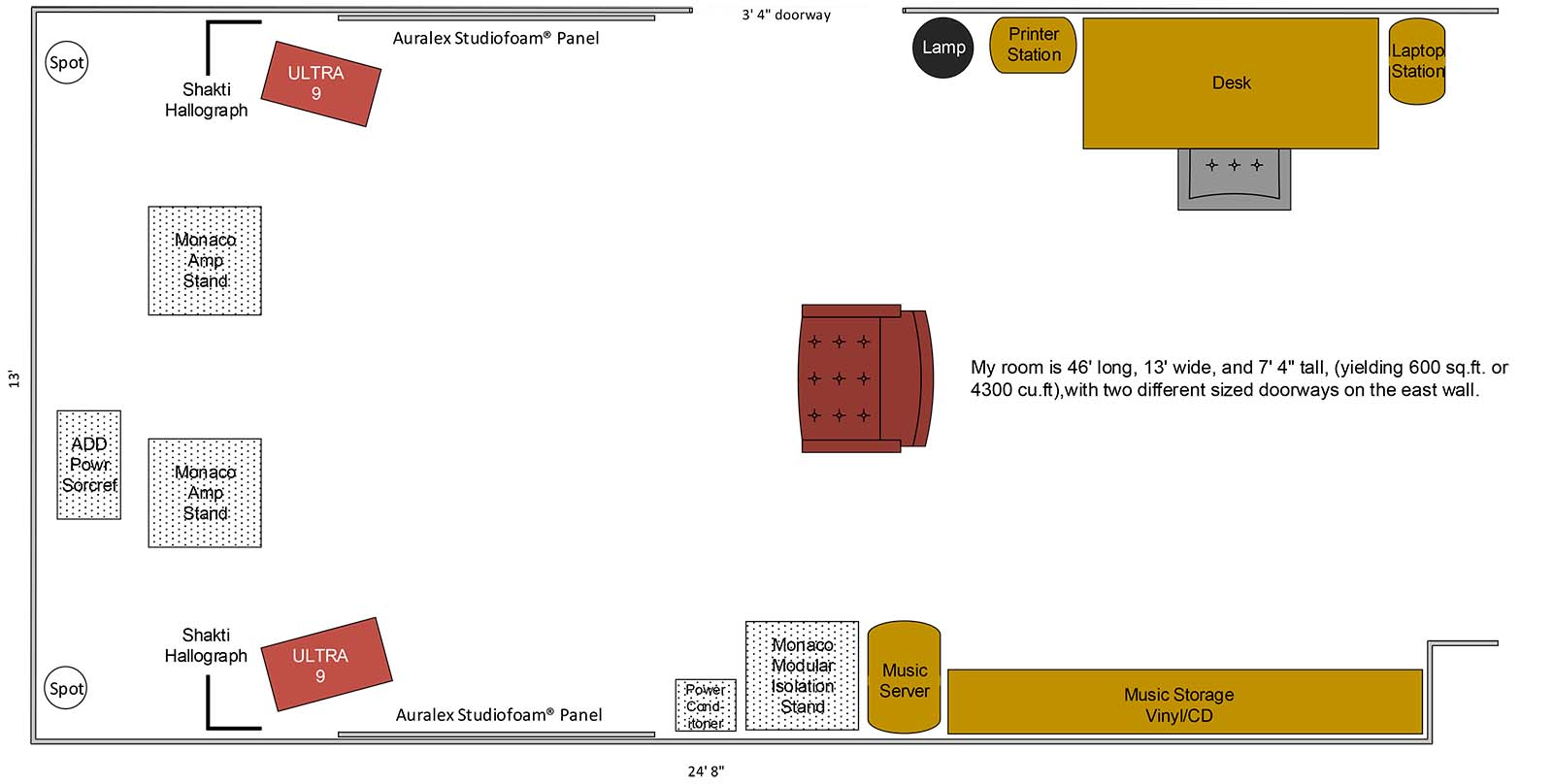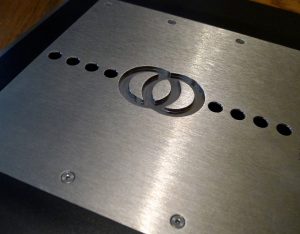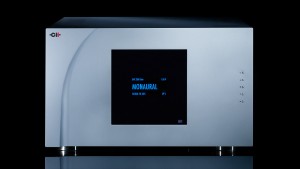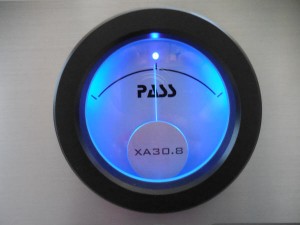The Constellation Audio Inspiration 1.0 Linestage and pair of 1.0 Stereo amplifiers, driving the GamuT Flagship Zodiac Loudspeakers.
From the Beginning
For a company that just recently celebrated only its 8th birthday, Constellation Audio has proven itself virtually unparalleled in both accomplishment and acceptance. My first take was at their 2010 CES introduction, where I caught up with designer Peter Madnick for the first time in some years. Peter's track record is, staying with the cosmic theme here, stellar.
In the mid-1990s, his Audio Alchemy products redefined the budget market and promulgated the use of a multi-box digital playback system, the use of a separate transport, DAC, power supply, and re-clocking device, rather than the previous paradigm of the one-box optical disc player. By the turn of the 21st century, he transformed that segment of the market again with the remarkably versatile and overachieving Perpetual Technologies digital gear. Having owned and written about a good number of entrants from both of those distinctive product lines, and after learning that his only charge at the helm of Constellation was to build the best products possible, without any price constraints, I admit to having grand expectations.
It also didn't hurt that I knew a little history of Constellation Audio's founders, David Payes, an outgoing Australian businessman and attorney, and Dr. Murali Murugasu, a Glasgow-trained physician, whose earlier and first cost-no-object venture into high-end-audio manufacturing came years earlier with the creation of Continuum, and the introduction of the groundbreaking $150,000 Caliburn turntable at CES 2005.
Launching a new line by introducing your Reference products first, including the (then) $140,000/pr. Hercules monoblocks and the $65,000 Altair linestage, was audacious, to say the least. By the fall of 2011 many of my colleagues were touting Constellation Audio's accomplishments, some even suggesting that they set a new benchmark in solid-state amplification. I will admit that I was not completely won over by this original lineup. While their transparency and resolution were exquisite, I found that brands like Soulotion and darTZeel seemed more capable in the areas of bass extension and impact, and at replicating the body and bloom of instruments and the soundstage. Still, it was an interesting and auspicious introduction, as the casework, circuit design, and engineering efforts were undeniably heroic.
My opinion of the sonic accomplishments of Constellation Audio was soon to change. Following on the heels of the Reference series, they introduced a slightly less sophisticated line of components, based on the same topology as the Altair and Hercules. Called the Performance series, we were soon introduced to the $24,000 Virgo preamplifier and Centaur power amplifiers ($24,000 stereo, $54,000 monoblocks).
It was only in 2014 that the Inspiration series, including the 1.0 linestage, and 1.0 stereo and mono amplifiers (this lineup now includes an integrated amplifier as well) arrived and exhibited so very much of the DNA of their larger brethren, that they created quite a stir. Each series of Constellation electronics is based on the exact same circuitry developed for the Reference products, simply scaled down in implementation to allow for their more cost-effective execution.
Knife Edge
While I won't go into exhaustive detail on the circuitry used in these exceptional devices, I must point out that they are, in a word, inspired (pun intended). I'd point you to any of the more exhaustive treatments available from other sources, but I must make mention of some decidedly relevant points.
First, the design and implementation of the Inspiration series is unique in my experience; no other electronics manufacturer I am aware of uses the identical topology, schematics, and boards in their entry level offerings as used in their flagship lineup. You may want to read that again, and let the power of that statement sink in.
Where the Reference series may employ only the finest available devices (coils, resistors, capacitors, diodes, etc.), regardless of cost, the Performance series opts for less costly, yet still high performing and close tolerance versions. Inspiration uses creative adaptations in order to populate its boards with devices of slightly lesser tolerances or performance. And, where the Inspiration chassis are fabricated from CNC-machined aluminum slabs (with the industrial design team led by Alex Rasmussen of Neal Feay), crafted in the same metal shop that builds the enclosures for the Reference and Performance series components, they are markedly less elaborate and massive.
All Constellation preamplifiers are based on what they characterize as the Line Stage Gain Module, a topology that uses servo circuits to maintain as perfect a balance between the positive and negative halves of the audio signal as possible. But where the Altair uses an external power supply housed in separate, matching casework, the Inspiration 1.0 employs an integral supply. Both lines incorporate three transformers, with one separate R-Core (chosen for their inherently low noise and low radiated magnetic energy) for each channel (dual-mono), and a third (a more conventional El core) to drive all the controls and display. Where the Altair uses four-stage regulation, the Inspiration 1.0 manages with three.
One of the largest differences between the Altair and Inspiration 1.0 can be found in the volume control. Where Altair originally used a ground-breaking and unprecedented light-dependent resistor, and now, due to the length of time it took for that resistor to stabilize and sound its best, uses a digitally controlled monolithic stepped-attenuator, Inspiration employs a very effective chip-based monolithic resistor array.
Even at this level, all circuit boards are isolated from the main chassis using a pliable material to prevent microphonics and other vibration-induced distortions. This linestage also uses mirror-imaged, symmetrical, preamp circuits, one for the positive half of the signal, one for the negative half, helping to cancel interference and greatly enhance the slew rate (Constellation claims a doubling here), yielding an impressive 100-kilohertz frequency response.
The stereo and mono amps are based on the same Balanced Bridge topology developed for the Hercules. This topology uses two separate single-ended amplifiers per channel, one driving the positive half of the balanced signal, the second driving the negative half of that wave (with neither channel referenced to ground), which combine to make each channel of the stereo output by using the speaker to "bridge" those independent outputs. Further, the entire output stage is comprised of two precisely matched, same-polarity N-channel transistors (a method also employed by other companies such as GamuT), rather than being made up of the more standard configuration, balancing complementary N- with P-channel transistors.
The Constellation Inspiration 1.0 Linestage, sitting on CenterStage2 footers, on my Grand Prix Audio Monaco Isolation rack
With a profile of 17" wide, 15" deep, and 5.5" tall, weighing in at a lithe 25 pounds, the 1.0 linestage has a distinct appearance. The faceplate, while not as ornate or asymmetrical as its more accomplished brethren, sports a 9" wide by 3 1/16'' tall control panel (centered horizontally, but somewhat closer to the top of the chassis than the bottom), protruding forward some 5/8". It houses a centrally located 3 ¾" wide by 2" tall monochrome LCD touchscreen, and two 1 ½" round knobs, one to either side of the display, with their functions etched into the aluminum immediately above them, Balance to the left, Volume to the right. This panel also features 5 small, round display navigation buttons centered under the LCD on the bottom surface of the protrusion, as well as the Constellation logo in the lower right corner. From left to right, they are Home, Return/Back, Power, Multifunction, and Mute, and these buttons functions vary depending on which menu you are in, offering options like muting or absolute polarity selection. This display and the nav buttons allow the user remarkable versatility and control of the 1.0 Linestage from this display.
The rear layout is just as elegantly simple, in mirror image, to accommodate the symmetrical circuit layout. Two large cutouts in the external case, each nearly half the width of the back of the chassis and occupying the upper two thirds of the panel, allow access to the inputs and outputs to each left and right channels sub chassis. Looking at the left channel, there are two rows of connections, XLRs above, and RCAs below, staggered horizontally between the XLR connections. From left to right in the top row we have balanced inputs 1, 2, and 3, then slightly closer to the center of the chassis are balanced outputs 1 and 2. In the RCA row below, we find inputs 4, 5, and 6, then RCA outputs 1 and 2. The right channel is a mirror image of the left. Just below the left channel opening we find a DB9 (RS232) port, for home automation connection, a USB B port, also for home automation use or firmware updates, and a 3.5mm trigger input. Under the right channel opening is the IEC block, containing a standard IEC C14 male inlet, and a rocker power switch.
The right Constellation Inspiration 1.0 Stereo amplifier, sitting on a Grand Prix Audio Monaco Amplifier stand
The 1.0 Stereo amplifier is 17" wide, 19" deep, and 8.5" tall, tipping the scales at a respectable 80 pounds. The front bears the same distinctive sculpting as the linestage, and one long button, 9 ¼" wide, by ¾" tall, centered on the face horizontally, but some 2 ½" from the bottom, with the name Constellation Audio etched into its rightmost quarter. This unorthodox button does not depress uniformly, rather, it pivots from the right, meaning you must push the left side to activate it (a bit confusing on first blush, but rather elegant and sophisticated once you acclimate to its use). Its centrally mounted LED shows flashing green when powering up, solid blue under power, flashing blue when muted, solid red in standby, and flashing red when cooling down.
The rear of the 1.0 Stereo is also symmetrically laid out, with mirror imaged left and right in- and outputs. Looking to the left side of the rear panel, we first find two balanced inputs, centered vertically, one above the other, with the lower being the "Direct" input, something to be used only with Constellation preamplifiers (more on this later). Below that "Direct" input is the singe-ended RCA input. Several inches further toward the center are the large, plastic knobs of the 5-way binding posts for the right channel speaker outputs. The Left channel inputs and outputs mirror this arrangement.
Just above the upper (not the "Direct") Balanced input to the left are two bat-handled micro switches, the upper one to Mute the amplifier, the lower to select Balanced/Direct or Single Ended inputs. Slightly higher on the back panel, centered well above and between the speaker binding posts is the AC entrance, featuring a large IEC C20 male inlet (limiting the use of cords to those of a specific design) and a large rocker power switch. Just below that entrance, from left to right, matching the linestage, are a DB9 (RS232) port, a USB B port, and a 3.5mm trigger input.
The remote is also machined aluminum, narrow and very slim (7 ¼" long, by 1 ½" wide, by ½" at its thickest), with eight buttons; Standby, Mute, Vol Up, Vol Down, Balance >, Balance <, Input, and Phase.
In short, Constellation likes to say that the Inspiration series represents a distillation, not a dilution, of their Reference and Performance products, retaining the subjectively musical yet objectively exceptional performance that has earned them such acclaim. I would agree that what they have accomplished with this series is both sophisticated and highly engaging. Let's give a listen, shall we?
Tiger in a Spotlight
When I first spoke with Irv Gross, Constellation's Vice President of sales, about this review opportunity, we decided to pursue something just a bit different; this audition would feature a pair of the Stereo 1.0 amplifiers, rather than a pair of monos, and would report on their use in a vertical biamp configuration. During this audition, I was able to pair them with my reference Von Schweikert Audio VR-55 Aktive ($60,000/pr.), GamuT's flagship Zodiac ($150,000/pr.), and the new Von Schweikert Audio ULTRA 9 loudspeakers ($200,000/pr.).
While I was able to apply a variety of cable looms over the period of this audition (Audience, Furutech, MasterBuilt, Stealth), the substance of this report is based on performance noted using only the Stereo 1.0 amplifier's factory power cords (mandated by their IEC C20 male inlet), Stealth Audio ICs and speaker cables, Audience Au24 SX USB and powerChords, and the Von Schweikert Audio VR-55 Aktives.
The uniqueness of the IEC C20 male inlet (rather than the more typical C14 type found on the Linestage and most other amplifiers) on the 1.0 Stereo amplifier limited the cords I could use with these amps to only the provided stock cable, which, to be fair, performed admirably. I just had no way to compare the performance of better AC Cords
Sources were either my Kronos Sparta turntable, Helena tonearm, and Air Tight PC-1 MC cartridge, feeding my DSA Phono II phono stage. Digital was rendered by either my own Windows 10 based PC, using either J. River 24 (64-bit), with Fidelizer v8.3, or Roon 1.6, or my extensively modified McCormack UDP-1, with both handing off to my Hegel HD30 DAC. Power conditioning was managed with the new PS Audio DirectStream P20 Power Plant, an Audience aR12-TSSOX, and 2 Quantum Symphony Pros.
To those of you who have followed my work over the decades, it will come as no surprise that I find bass performance to be foundational to the overall gestalt of the sonic signature any product is capable of delivering. In this regard, the Inspiration 1.0 linestage, and the 1.0 Stereo amplifier in particular, are conspicuously exceptional! While my experiences with the original Hercules, and even the Centaur monos at introduction, found those products to be extremely detailed, articulate, and capable of distinctly defined pitch, overall, they were considerably politer in this region; by that I mean noticeably lacking in overall impact and weight.
Not so with the Inspiration lineup. Bass here is very well controlled, superbly detailed, offering scintillation pitch definition, but capable of bringing the slam, weight, and impact much closer in authority to something like my reference Audionet PRE G2/MAX mono system. While I cannot substantiate them, there are rumors to the effect that once the Inspiration series was introduced, that the advancements they realized in low frequency performance predicated the redesign of both the Performance Series Centaur and Virgo II, resulting in the Centaur II/Virgo III iterations.
This exceptional level of performance continues on through the mid-bass and into the midrange regions as well. Inspiration delivers tone color, textural content, and most interestingly, the overwhelming clarity of the individuality of instrumentality, like nothing else solid-state in its class. I was consistently treated to the tonal beauty of piano, reed, and brass instruments, surprisingly replete with their unique and vivid textures, and an incomparable sense of their individual and distinctive voices with this amazing teaming of electronics.
How can I describe the treble region? To simply say that it is strikingly reminiscent of the world-class signature Constellation air, resolution, and delicacy hardly seems adequate. There is a sophistication, an elegance, an intricacy to the uppermost regions here that is both intoxicatingly genuine, and next to impossible to find from other products at this price point. Make no mistake, this region is virtually unsullied with the typical tainting, smearing, or homogenization observed with many other solid-state contenders in this price range.
Another area where Inspiration excels is in its ability to present an exceptionally accurate soundstage. Images are reconstructed with remarkably truthful scale, and there is an undeniable sense of openness and correctness to their size and location, recording permitting. This attribute, when combined with their previously noted abilities to render authentic tone color and texture, set it apart from any of its similarly priced competition.
While I wouldn't say Inspiration can compete on even footing with excellent tube gear in its ability to portray the openness, body, and the bloom of voices, it is nonetheless exceptionally accomplished in these most crucial areas. Instrumental outlines are clearly defined, easily identified, and in proportionate scale; cellos sound characteristically larger than violins or violas, yet are easily distinguished as slighter in size and voice than the double bass. While I know of solid-state contenders that are more accurate here, subjectively, you'd have to spend something on the order of twice as much or more to realize any considerable betterment in those categories.
There is also an inescapable ease and distinct capacity to differentiate and render fine degrees of dynamic scaling, both deep down in level by the noise floor, and in their ability at conveying the jolt and verve of strikingly lively dynamic contrasts.
Many of the sonic qualities I've just described are most decidedly a result of the overall exceptional level of transparency and resolution this most affordable Constellation lineup brings to the table. And as such, Inspiration simply defines class-leading performance.
My use of the terms transparency and resolution here are not euphemisms for characteristics such as bright or super-detailed; it is not code for excessive upper-midrange or treble energy. True resolution reveals detail and nuance, uncovering microdynamic subtitles such as extremely fine transient detail or the subtleties of instrumental tone color and texture. It is indicative of the enhanced ability to follow a single instrumental line deep within dense and convoluted arrangements, or by the depiction of a starker sense of the space between and around images within the soundstage, and in truth, is the defining characteristic determining the equipment's ultimate limit of transparency.
This all translates to remarkably well fleshed out soundstaging and imaging capabilities, with finely graduated delineation of depth (especially to the sides of the stage as it recedes), more correct instrumental voice sizes and height cues, and the development of the fundamental spatial interrelationships between instruments, including the space and air around and between them.
The Inspiration electronics were provided with no manuals in the boxes. Users are asked to download the latest iteration from the Constellation Audio website.
As an aside, if you've been following my remarkable journey with the Critical Mass Systems CenterStage and CenterStage2 footers, their introduction under the linestage and both stereo amps elevated their already stunning performance to astronomical heights. In my experiences, those bloody things are utterly magical!
As I've touched on, I used this trio in a number of configurations over the audition period, using different combinations of balanced inputs (including the "Direct" option), as well as the single ended input, necessarily cascading it to both channels for the vertical biamp capability. While I found marginally improved quietness and microdynamic involvement using balanced over single ended connections, the XLR "Direct" balanced input (only applicable when using any series of Constellation preamplifiers), was my least favorite option sonically. I found this a bit surprising, as Constellation describes this Direct audio interface as allowing the positive- and negative-phased halves of the signal to exhibit near-zero difference except for their polarity. However, I found it seemed to slightly roll off the lowest bass performance, which, while contributing to the appearance of more detail and an enhanced sense of resolve, did so at the cost of the overall sense of power, weight, and impact. While it may be different in other installations, I found the use of the extra gain stage (bypassed in Direct mode), to be notably less analytical sounding and more musically engaging.
Hoedown
In all, I am unaware of a more accomplished, articulate, resolute, transparent, and musically engaging series of electronics in this class. And while not exactly cheap, with a system price of about $32,000 for the three components, they demonstrably punch so far above their weight (forgive the idiom, but it is warranted), representing such unquestionable value as to stand head and shoulders above many similarly priced competitors I've heard from the likes of Aesthetics, Air Tight, Audio Research, Bryston, mbl, Sutherland Engineering, VTL, Zanden, and Zesto.
Inspiration brings a level of clarity, resolution, and dynamism to the table previously unavailable at this price range. In fact, I have reached out to Irv Gross and Constellation requesting to be able to keep them on-hand as an unquestioned reference in their price range. I will be more than just a little disappointed to see this gear leave my system. Most enthusiastically recommended.
1.0 Linestage
Retail: $9900
- Inputs: 3 XLR stereo, 3 RCA stereo, USB (for control)
- Outputs: 2 XLR steroe, 2 RCA stereo, 12-volt trigger
- THD+N: <0.001%, 20 Hz - 20 kHz @ 2V out; <0.1%, 20 Hz - 20 kHz @ 10V out
- Frequency Response: 10 Hz to 100 kHz, ±0.5 dB
- Signal-to-noise ratio: >-105 dB, A-weighted
- Input impedance (balanced): 20 KΩ
- Input impedance (unbalanced): 10 KΩ
- Output impedance: < 50Ω
- Volume control resolution: 0.5dB from 0dB to -90 dBFS
- Weight: 25 lbs. / 11.3 kg
- Dimensions: 17" x 15" x 5.5" / 43.2cm x 38.1cm x 14cm
1.0 Stereo amplifier
Retail: $11,000
Specifications
- Inputs: 1 Constellation Direct XLR, 1 standard balanced XLR, 1 unbalanced RCA
- Outputs: metal binding posts
- Power output: 200 watts, 8Ω (1 kHz @ 1% THD+N), 400 watts, 4Ω (1 kHz @ 1% THD+N)
- Gain: 14dB Constellation Direct, 26 dB Balanced & RC
- Output noise: <70 ?V, 500 kHz BW, -116 dB @ 250 watts
- Damping factor (8Ω load): 80
- THD+N: <0.05%, 1 kHz @ up to 90% of rated power
- Frequency response: 10 Hz to 80 kHz, +0/-0.5 dB
- Signal-to-noise ratio: >-95 dB, A-weighted
- Input impedance (balanced): 20 KΩ, Constellation Direct, 20 KΩ XLR
- Input impedance (unbalanced): 10 KΩ RCA
- Output impedance: 0.1Ω
- Weight: 80 lbs / 36.3 k
- Dimensions (W x H x D): 17" x 19" x 8.5" / 43.2cm x 21.6cm x 48.3cm
Constellation Audio
Suite 1, Level 6
580 St. Kilda Road
Melbourne, Vic 3004
Australia




